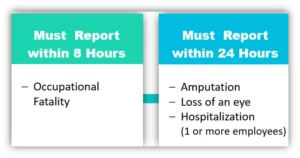By Phil Molé, MPH
It’s that time of year again! Employers covered by OSHA’s Recordkeeping Standard should already have their Form 300A signed and posted, and employers at establishments covered by electronic reporting requirements need to submit their 2022 300A data to OSHA by March 2. As the electronic reporting deadline approaches, it’s a good time to take a moment to sharpen your understanding of the OSHA Recordkeeping Standard. In what follows, we’ll address your OSHA Recordkeeping frequently asked questions (received during webinars and in-person speaking events) and share some helpful resources.
Background on OSHA Recordkeeping Standard
It’ll help our discussion to start with a little background.
OSHA’s Recordkeeping Standard covers all employers covered by the Occupational Safety and Health (OSH) Act. This includes all employers with 11 or more employees in the company at any time during the calendar year, unless their NAICS code is included on the Partially Exempt List. All employers covered by the rule are required to keep occupational injury and illness records including the Log of Work-Related Injuries and Illnesses (Form 300), individual Injury and Illness Incident Reports (Form 301s) for each recordable injury or illness, and the Summary of Work-Related Injuries and Illnesses (Form 300A).
This last form, the 300A, is especially important right now. If you’re an employer subject to OSHA Recordkeeping requirements, you should already have had your 300A form completed, signed, and posted in an accessible location by February 1, and you’ll need to keep it posted until April 30th.
Another important note is the use of the term partially exempt above. No employer covered by the OSH Act is completely untouched by OSHA Recordkeeping obligations. Even though employers with ten or fewer employees in the company or those who are in one of the low hazard industries listed on the partially exempt list are not required to maintain OSHA Recordkeeping forms, they are still required to report any work-related fatalities (within eight hours), hospitalizations of one or more employees (within 24 hours) and any incidents involving amputation or loss of eye (within 24 hours).
Additionally, some establishments covered by the OSHA Recordkeeping Standard also need to electronically transmit certain injury and illness records directly to OSHA via a web-based interface called the Injury Tracking Application (ITA). Specifically, those establishments need to submit their 300A injury and illness summary data in electronic format by March 2 of each year for the previous year’s calendar year data.

The ITA reporting obligation applies to establishments covered by OSHA’s electronic Recordkeeping Rule with 250 or more employees, as well as establishments with 20-249 employees that are covered by the Recordkeeping Standard and operating in certain industries with high rates of injuries and illnesses.
With that background out of the way, let’s address your OSHA Recordkeeping frequently asked questions.
Questions About Recordkeeping Standard Applicability
Q. Are partial exemptions for Recordkeeping applicability based on the NAICS code of the company, or the specific establishment? For example, what if a company with a main NAICS code subject to Recordkeeping had establishments that performed only office functions, with NAICS activity codes listed as being partially exempt?
A. OSHA hasn’t always been crystal clear on this issue but when you read the regulation, it states that establishments are only covered by full OSHA Recordkeeping obligations if they have an NAICS code that isn’t partially exempt. OSHA gave probably the clearest statement in the FAQ linked below, in which they said, “The partial industry classification exemption applies to individual business establishments. If a company has several business establishments engaged in different business activities, some of the company’s establishments may be required to keep records, while others may be partially exempt.”
In short, an individual establishment would be partially exempt and not have to maintain OSHA Recordkeeping forms if its NAICS code is partially exempt, regardless of what the larger company’s NAICS code may be. OSHA provides more details in the FAQ linked here: https://www.osha.gov/recordkeeping/faq-search?combine=NAICS
Q. What about establishment size? Is my establishment partially exempt if there were 10 or fewer employees working there at any time last year?
A. This is one of the most common of the OSHA Recordkeeping frequently asked questions we’ve encountered over the years. And the answer is “no.”
One of the most frequent Recordkeeping mistakes is misunderstanding the “small employer exemption,” and mistakenly determining applicability for Recordkeeping based on numbers of employees at the establishment, rather than at the company.
The regulatory text and OSHA’s guidance over the years clearly state that applicability of OSHA Recordkeeping requirements is based on the number of employees at the company level, rather than the establishment level. For example, 29 CFR 1904.1 (a)(1) states “If your company had 10 or fewer employees at all times during the last calendar year, you do not need to keep OSHA injury and illness records unless OSHA or the Bureau of Labor Statistics informs you in writing that you must keep records under § 1904.41 or § 1904.42.”
If you manage an establishment that is not partially exempt from OSHA Recordkeeping due to its NAICS code and is part of a company that has 11 or more employees, you will have Recordkeeping obligations including completion, signing and posting of the 300A form from February 1 thru April 30 each year. In fact, every establishment location of the company that is not partially exempt based on NAICS would be covered by OSHA Recordkeeping requirements.
Q. The company’s average number of employees last year was only 10. Am I partially exempt?
A. No, and this is another of the more common misunderstandings among the OSHA Recordkeeping frequently asked questions we see.
Let’s take another look at the text of 1904.1(a)(1) above, and the phrase “at all times” included there. This means that if the number of employees at your company exceeded 10 employees, at even one time during the previous calendar year, the small employer exemption does not apply.
This is why companies that have significant seasonal labor trends, such as spikes in employment numbers during peak seasons, will have to be careful to track whether the maximum number of employees exceeds 10 at any point during the year. If the number exceeds that threshold, and the company is not partially exempt based on NAICS code, all its establishments that also have OSHA Recordkeeping-covered NAICS codes would need to maintain OSHA Recordkeeping forms.
Questions About Determining if Injuries and Illnesses are Recordable
Another very common category of OSHA Recordkeeping frequently asked questions we get is what injuries or illnesses must be recorded on OSHA Recordkeeping forms. The criteria for determining “work-relatedness” of injuries and illnesses can be confusing, so let’s address some of the most common issues.
Q. Are injuries while working from home recordable?
A. We’ve been getting this question more frequently because of the increase in remote work over the past few years.
OSHA maintains that in a work-from-home situation, the home is only considered to be the work environment when the employee is directly involved in work for their employer. For example, if an employee is using a sewing machine at home in performance of work duties for their employer and injures a finger significantly enough to require stitches, that would be work-related and a recordable injury. By contrast, if the employee had taken a break from working to walk the dog, tripped, got injured and needed medical treatment, that would not be work-related and not be recordable.
Q. When are employee vehicle accidents recordable? Is a vehicle accident recordable during the employee’s commute? What if the accident happens as the employee is arriving at work or leaving?
A. We’ve had many questions about this over the years, so let’s explore some of the nuances.
Part of the equation for determining work-relatedness and recordability of vehicle accidents is whether the employee was performing work for their employer, or “in the interest of their employer” (to use OSHA’s phrase) at the time of the accident. You might interpret “in the interest of their employer” as including commuting to and from work. However, OSHA specifically excludes scenarios where an employee was in the process of commuting at the time of the accident.
In 1904.5(b)(2)(vii) and in related letters of interpretation, OSHA states that employers can exclude cases when an employee is injured in a motor vehicle accident while commuting to or from work, even when an accident occurs in a company parking lot or company access road while the employee is arriving or leaving. Therefore, an accident that occurs as part of the employee’s regular commute from the home to the workplace and back again is not recordable — this includes remote work situations in which the employee had established a “home away from home” such as a hotel accommodation near the work location.
However, if the employee had already arrived at work and then, e.g., ran out to a supply store at the request of the employer and got into a car accident during performance of that employer request, it would be work-related and would be recordable if recording criteria were met, such as a hospitalization, medical treatment beyond first aid, days away from work, or restricted duty. Of course, if an employee is driving for their employer outside of a commute, such as a drive between company locations or in performance of their job duties, an accident would potentially be recordable, too.
All that said, it’s important to stick to the letter of the law when interpreting which vehicle accidents are recordable. For example, if an employee is struck by another vehicle in the company parking lot after she’s already left her car to enter the workplace, that’s no longer a commuting accident. The commuting exception also wouldn’t apply if, for example, the employee was arriving at or leaving the employer’s facility on a lunch break. Vehicle accidents at or during work that don’t meet the commuter exception criteria would be recordable if it also involved any general or specific recording criteria, such as medical treatment or days away from work.
Q. How “restricted” does an employee’s work routine need to be to count as a “job restriction or transfer case?” For example, what if the employee could still perform 80% of their work routine?
A. It’s important to have an accurate understanding of how OSHA defines “job transfer or restriction” cases for a couple of important reasons. First, job transfers or restrictions due to an occupational injury or illness are among the criteria that make injuries and illnesses recordable on OSHA Recordkeeping forms. Employers also have an obligation to properly classify injuries and illnesses on the 300 log and track the number of days of restricted work an employee performs.
OSHA’s definition of restricted work in 1904.7(b)(4)(i)(A) is cut-and-dried: “Restricted work occurs when, as the result of a work-related injury or illness, you keep the employee from performing one or more of the routine functions of his or her job, or from working the full workday that he or she would otherwise have been scheduled to work.”
So, if there’s even one routine job function an employee can’t perform due to a work-related injury or illness, it’s a restricted duty case.
Questions About OSHA Injury and Illness Reporting
In addition to recording injuries and illnesses on the proper OSHA Recordkeeping forms, you may also be required to report injury and illness data directly to OSHA. OSHA takes these reporting obligations very seriously, and the injury and illness data OSHA obtains through employer reporting is critical to the Agency’s mission of improving worker health and safety. Here are some key OSHA Recordkeeping frequently asked questions about injury and illness reporting requirements.
Q. Which injuries and illnesses do I need to report to OSHA? How do I report them?
A. For most recordable injuries and illnesses, employers only need to record them within 7 days. However, there are several categories of serious injuries and illnesses that the employer must report directly to OSHA. The chart below summarizes those categories and the associated time limits.

There are several ways you can report these incidents to OSHA:
- You can call the nearest OSHA office;
- Call the OSHA 24-hour hotline at 800-321-6742; or
- File the report using OSHA’s online system
One thing to note: Don’t confuse this reporting of serious injuries and illnesses with a kind of reporting addressed by another of the OSHA Recordkeeping frequently asked questions addressed in this blog: electronic annual reporting of certain injury and illness data.
Q. If I’ve already submitted my electronic 300A data, do I need to resubmit if I revise my 300A data?
A. First, let’s discuss some of the reasons why you may need to update your OSHA Recordkeeping forms, regardless of electronic reporting obligations.
There are times that details about a specific injury or illness case may change. One common example involves classification of cases as either “days away from work” (Column H on Form 300) or “job transfer or restriction” cases (Column I). You may recall that per OSHA’s instructions for Form 300, employers should classify each case as one and only one of the specific categories in Columns G through J, depending on the severity of the case.

So, if a given case involves both days away from work and restricted duty work, you would only classify the case as days away, because that’s the more severe outcome. Often though, a case starts as restricted duty but then becomes a days away case once the full extent of the injury or illness is understood. At that point, the employer should reclassify the case as days away.
These classifications and reclassifications help ensure that the employer’s injury and illness data is accurate, and that EHS managers have correct information about patterns and severity of injuries. A misclassification of an incident on Form 300 can lead to incorrect totals on the 300A, which summarizes overall numbers of recordable incidents, including days away and job restriction cases.
Because the 300A involves a certification statement that the information within is true and accurate, and OSHA relies on the information within to inform their regulatory and enforcement activities, it’s important that the information OSHA has from your establishment is accurate. So, if injury reclassifications occur after your ITA submission that change the numbers of (e.g.) days away from work and restricted duty cases, the employer should submit a revised version of the 300A.
Q. I’ve heard that OSHA is changing electronic reporting requirements. What will be changing, and how should I prepare?
A. Of all the OSHA Recordkeeping frequently asked questions discussed in this article, this is the one we’ve been getting most often in recent months, as word has spread that requirements are changing.
OSHA published a Notice of Proposed Rulemaking (NPRM) in the Federal Register on March 30, 2022. After receiving and sorting through stakeholder feedback during the pubic comment period, OSHA published a final rule updating electronic reporting requirements on July 21, 2023.
The final rule leaves some current electronic reporting requirements unchanged, but also significantly expands requirements for other establishments. Additionally, the NPRM’s proposal to publish data submitted by establishments revisits some of the intentions and objectives of the original rulemaking that established OSHA’s electronic reporting requirements.
At a very high level, the OSHA final rule creates 4 different categories of electronic reporting obligations, depending on establishment size and industry sector, as shown in the chart below.

Let’s look at the major proposed changes in the final rule.
Expanded Reporting Requirements: The final rule requires establishments with 100 or more employees in certain designated industries to electronically submit information from their OSHA Forms 300, 301, and 300A to OSHA once a year. This would be a major expansion of reporting requirements, since as previously mentioned, OSHA rescinded requirements originally contained in the 2016 final rule for some establishments to electronically submit 300 and 301 data before the phased-in requirement went into effect.
The industries affected by this new requirement would be listed in a proposed Appendix B to Subpart E of the Recordkeeping Standard. All establishments with 100 or more employees in industries listed in the proposed Appendix B to Subpart E are already required to electronically submit 300A data to OSHA once a year under current 29 CFR 1904.41 (i.e., they’re also in Appendix A), but would now need to additionally submit data from their Forms 300 and 301. Employers at affected establishments would submit data from all three forms via the ITA.
As the chart above shows, electronic reporting requirements will not change for establishments listed in Appendix A of Subpart E with 20-249 employees, or establishments subject to Recordkeeping Standard obligations that have 250+ employees.
Publication of Data: The final rule states that OSHA will post the data from the proposed annual electronic submission requirement on a public website after identifying and removing information that reasonably identifies individuals directly, such as individuals’ names and contact information. Many comments submitted to the docket during the public comment period for the NPRM expressed had expressed concerns about this provision, but OSHA included it in the final rule.
Remember, the 300A data that establishments covered by electronic reporting requirements currently submit only has summary level info about numbers of certain types of cases, but the 300 and 301 forms contain much more specific information about individual cases. Some of that info may include identifying details about the employee(s) involved, and so may potentially disclose confidential information protected by the Health Insurance Portability and Accountability Act (HIPAA). OSHA’s final rule states that that the agency “plans to use automated de-identification technology, supplemented with some manual review of the data, to identify and remove information that could reasonably be expected to identify individuals directly from the fields the agency intends to publish,” and that “the agency will not publish text-based data until such information, if any, has been identified and removed.” The Federal Register notice also states that for coded data, OSHA plans to use an automated coding system to code the collected data, and that until the autocoding system has been tested and is in place, OSHA intends to only use and publish uncoded data. It remains to be seen how OSHA will sort out the details on how to strip out protected information, or how long it will take them to put what they consider to be effective enough systems in place to move forward with publishing employer injury and illness data.
The final rule goes into effect on January 1, 2024. In the Federal Register notice for the final rule, OSHA states that “because this final rule becomes effective on January 1, 2024, OSHA intends for March 2, 2024 to be the first submission deadline for the new information required to be submitted under this rule.” This means that establishments with reporting requirements under the final rule will need to be ready to submit their 2023 calendar year data by March 2, 2024, and need to start preparing today. If you’re an employer affected by these changes, you don’t have to spare to start looking for the right tools to sharpen your incident management, recordkeeping and reporting capabilities now.
Looking for More Information?
If you still need more information after reading through these OSHA Recordkeeping frequently asked questions, we have you covered.
Check out our recent on-demand webinar covering OSHA’s 2023 final rule to learn more about how the coming changes affect you, and how to prepare.
You can also download our OSHA Recordkeeping Infographic for a handy, common-sense guide to determining which injuries and illnesses are recordable or reportable, and for a really deep dive into OSHA Recordkeeping, check out our popular on-demand webinar.
Let VelocityEHS Help!
The VelocityEHS Safety Solution includes easy-to-use incident management capabilities to streamline OSHA Recordkeeping obligations by enabling you to automatically generate required OSHA forms, including the 300A you’re required to post on-site each February. The software also helps quickly generate electronic 300A data in correct file format with just a couple clicks to dramatically simplify compliance with electronic reporting requirements via OSHA’s ITA.
In addition to streamlined OSHA Recordkeeping, our Safety Solution also simplifies management of your chemical inventory and SDS library, inspections, safety meetings, emergency response, and much more while giving you access to key safety data and actions from anywhere. Visit the VelocityEHS solution landing page to learn more or request a demo.
